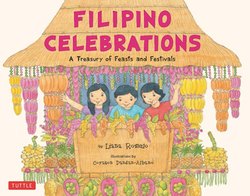Читать книгу Filipino Celebrations - Liana Romulo - Страница 8
На сайте Литреса книга снята с продажи.
ОглавлениеAll over the world Semana Santa, or Holy Week, is the most important week of the Christian calendar. It includes several religious holidays—Palm Sunday, Holy Thursday, and Good Friday—and ends the day before Easter Sunday. Semana Santa is also the last week of Lent, the forty-day period devoted to honoring the sufferings, death, and resurrection of Jesus Christ. Because the Philippines is mostly Roman Catholic, with parishes on more than seven thousand islands, there are many ways to celebrate Semana Santa.
The Pasyon is the story of Jesus Christ’s life, death, and resurrection. The first written version dates back to 1704; however, chanting the Pasyon began earlier as an oral tradition taught by Spanish missionaries and adapted into native dialect. It is chanted throughout Holy Week.
the foot-washing ritual
ang paghuhugas ng paa
In most churches on Holy Thursday, a priest performs a foot-washing ritual on twelve parishioners. Often they are costumed as apostles.
singing and chanting
pabasa
Pabasa involves singing or chanting the Pasyon. In rural villages, both young and old gather together to chant in the streets every day from six in the morning till ten at night, though one can also chant alone, or in pairs, for a couple of hours or for as long as several days in a row.
Stations of the Cross
During Semana Santa, we observe the tradition of walking through the Stations of the Cross—key episodes that took place as Christ carried a giant cross on His way to being crucified. Called Via Crucis, each station is portrayed through paintings or sculptures displayed in church. For example, in one picture Christ is crowned with thorns; in another He is shown falling down. Sometimes a priest leads a procession of life-size statues of the Biblical characters through barrio streets as townsfolk watch solemnly from the sidelines, the most traditional and religious among them chanting verses about the life and sufferings of Jesus Christ.
The Seven Last Statements
On Good Friday Catholics relive Christ’s last hours on the cross by recalling His seven last statements or siete palabras. Mainly we quietly pray, do readings, and reflect; but in some areas of the Philippines churchgoers even act out Christ’s suffering before His death. The final words before He died are spoken at precisely 3:00 in the afternoon, the hour of His death: “Father, into your hands I commend my spirit.”
Easter Encounter
The salubong, which means meeting, takes place early Easter Sunday. This is a typical Easter day scene wherein the grieving Mother of Christ meets her risen Son after His crucifixion. Statues of the Blessed Virgin (wearing a black veil to signify her mourning) and the Risen Christ are carried in procession in opposite directions, to meet later at the plaza or wherever the salubong will be held.
In San Fernando, Pampanga, and also in a few other towns across the archipelago, Christ’s crucifixion is re-enacted, with volunteers happy to have themselves actually nailed to a cross.
The Moriones Festival
On the island of Marinduque the colorful Moriones Festival takes place throughout the Holy Week. Devotees put on painted masks and headdresses, pretending to be Roman soldiers—the frightening men who tormented Christ, whipping and spitting on Him as He struggled under the deadweight of His cross. The Moriones, so-called because of the type of face armor they wore, attend evening processions in various towns, sometimes staging the story of Longinus.
Longinus was a Roman soldier who speared Christ’s body after the Crucifixion. A drop of Christ’s blood landed in his eye, famously curing his blindness. After this miracle, he converted to Christianity, which is why his fellow soldiers wanted to kill him.
